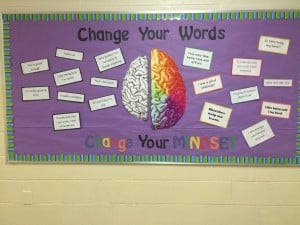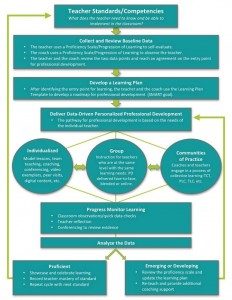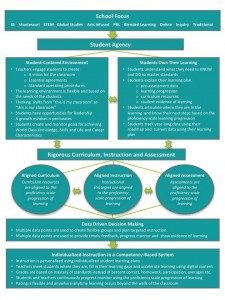Charleston: Progression of Implementation for Personalized Learning
CompetencyWorks Blog
 This is the second post in my site visit to Charleston County School District in South Carolina. Read the first post on building the CCSD framework here.
This is the second post in my site visit to Charleston County School District in South Carolina. Read the first post on building the CCSD framework here.
One of the big—no, huge—takeaways from Charleston County School District was the framework the district has created and the structure for personalized professional development. Thanks to Dr. Kristen Brittingham, Director of Personalized Learning;
Sherry Kirkland, Professional Development Administrator; Rebecca Mestaz, Marzano Research; and Personalized Learning coaches Kimberly Kascak, Kayela Clark, Hannah Studemeyer, Jessica Lucas, and Erin Abner for sharing their powerful insights.
Personalizing Learning for Teachers
CCSD has made two big advancements in the field of competency-based education. The first is a very strong framework of personalized learning that integrates competency-based learning, student-directed learning, and flexible learning environments (see the first post on CCSD for more information). The second is their “Personalized PD Model” (pictured below) for PL coaches to support teachers in building the capacity and developing the skills to implement the personalized learning framework. This progression allows the PL coaches to personalize the learning for teachers just as teachers will personalize for students.

All of the different concepts related to high-quality, personalized, competency-based learning cannot be taught or integrated all at once. Therefore, CCSD uses the Progression of Implementation to outline the competencies. Professional development modules and proficiency scales have been created around each of the competencies, with the PL coaches providing ongoing embedded support.
The PL coaches practice what they preach and make sure that learning for teachers is transparent just as the learning should be transparent for students. Teachers have learning plans based on proficiency scales just like their students do. Similar to the practices used for students, teachers are able to advance at their own pace. They show evidence of their learning and their progress is tracked using data notebooks or a competency-based digital learning platform called Empower (also being rolled out in Lindsay School District, Adams 50, and Maine). PL coaches use this data to guide their day-to-day work with teachers.
Ms. Kirkland explained, “We knew we had to create a way to expedite learning and create a personalized approach for teachers to advance. Just like students all progress at different times in different ways and take different pathways to get there, so do teachers.”
PL coaches also use a variety of teaching and learning strategies to personalize for teachers. Erin Abner, an elementary personalized learning coach, said that it is important to emphasize to teachers that they are not starting from the beginning in this learning process. “We start by affirming the best practices that they already have in place, such as the workshop model. We take them to visit teachers who are implementing personalized learning at a high level and they return with ideas on how to build upon their existing practices.”
Hannah Studemeyer, a high school personalized learning coach, reflected, “I’ve found that it is helpful for me to model new practices for teachers. For example, I go into classrooms and model unpacking standards and proficiency scales, or help teachers move through the process of creating a shared vision in their classroom. I plan with teachers and model how to create learning plans for students. Initially, some teachers are nervous and are hesitant to change, but then they quickly realize the value of building student agency.”
Progression of Implementation
CCSD understands that effective implementation starts with paying attention to the culture of schools and the relationships with them. When students feel respected, valued, and safe they will be open to learning. When the organizational and classroom rituals and routines help students build the skills and purpose needed for a strong sense of efficacy and agency they are going to be partners with teachers in the learning process.

- Student-Centered Culture and Climate: A growth mindset permeates personalized learning classrooms, setting high expectations for all students to master their standards and develop the skills needed to be successful in college and careers. Shared visioning, essential agreements, standard operating procedures, student voice, and student choice are all tools and strategies used in CCSD to create a student-centered culture. Students work with teachers to set individual and class behavioral and academic goals based on data. The philosophy transitions from this is “my” classroom to this is “our” classroom. Students lift each other up and play an integral part in each other’s learning. The physical environment of the classroom includes learning zones to meet the needs of all students based on their learning styles, interests, and differentiated activities. Students move in and out of the different zones based on the task on which they are working.
- Students Own Their Learning: When visiting classrooms that have reached a high level of implementation, it is evident that learning is transparent and students take ownership of their learning. Students can articulate what they need to know and what they need to be able to do to master standards. They are able to self-assess to determine where they are in their learning, they know what evidence is needed to demonstrate mastery, and they know when they have mastered a standard. Individualized student learning plans make the learning progression transparent and provide a structure for students to track their progress. These are essentially road maps to guide students through mastery of standards. Choices are provided to students regarding the pathway they take as well as the type of evidence they choose to use to demonstrate their learning. Data notebooks and a digital learning platform are used to track mastery of standards and to create a portfolio of student learning.
- Aligning Curriculum Resources and Instruction: Tasks, activities, technology integration, and instructional strategies are aligned to each level of the learning progression in order to provide students with on-target learning opportunities, regardless of where they enter the learning progression. As students progress, data from formative assessments is utilized to form small groups for explicit direct instruction. These groups are flexible and may change daily based on formative data.
- Aligning Assessments: Teachers use pre-assessments, formative assessments, and summative assessments that are based on the level of rigor of the standards, and are aligned to the learning progressions. Pre-assessments provide data to identify where a student enters the progression of learning. Formative assessments monitor where students are in their learning progression. Summative assessments measure the level of rigor of the standard and may include observations, formal tests, performance tasks, writing samples, etc. Summative assessments are not taken based on time (e.g., Friday test day); they are based on the readiness of individual students.
- Data Driven Decision Making: Multiple data points are used to create flexible groups, plan targeted instruction, provide students with immediate feedback, progress monitor, and show evidence of learning.
- Implementing Personalized Pacing: Once a strong foundation is built based on best practices in the progression, students are able to start learning at their own pace. Personalized pacing is grounded firmly in data and individual student’s learning plans guide them. Teachers conference often with students to monitor progress and clarify information. Formative assessment occurs every day, all day. Teachers use data to plan and deliver explicit direct instruction to small groups based on the needs of the students.
Engaged Students Motivate Teachers
A burning question throughout the visit was how to engage teachers without mandating that they move to personalized learning. I learned that engaged students are the key to motivating teachers. Erin Abner, a personalized learning coach, emphasized this point with, “When teachers visit a classroom implementing personalized learning, they see the passion that students have for learning. A personalized learning classroom provides concrete evidence that students love learning and have the capacity to own their learning. After seeing this, teachers are motivated to implement personalized learning practices in their classrooms.” Abner also noted that teachers have significantly shifted the way they teach, which, in turn, changes the way students learn. “Teachers can no longer depend on extrinsic motivation techniques. It is a disservice to students. We have to help students develop 21st century skills to prepare them to be successful in college, career, and life. This is what creates student engagement and motivates teachers.”
Jason Kraeger, a fourth grade teacher, reflected on his own experience. “I was skeptical of personalized learning at first but I was willing to give it a try,” he said. “After all, it was a horrible feeling to see students in my classroom bored, falling asleep, doodling, barely putting in effort. I knew I wasn’t reaching a large number of my students. Once I saw what was happening in the classrooms implementing personalized learning—every student was engaged—I wanted that in my classroom! After I implemented personalized learning and experienced students having a voice in the classroom and choices with how they learned, I knew I would never go back to the traditional way of teaching.” He noted that he was already seeing the effects that personalized learning had on student achievement with half of his class performing above grade level halfway through the year.
The Job of Personalized Learning Coach
The PL coach’s job is structured so they spend their time modeling personalized learning strategies, frequently meeting one-on-one with teachers to set goals, providing personalized instruction, tracking data based on individualized teacher learning plans, providing school wide and small group professional development, observing teachers and providing feedback, collecting implementation data, and facilitating teacher curriculum conversations.
In the words of PL coach Kimberly Kascak, “It’s about catalyzing change. You can’t move an entire school all at once, which means the coach’s job requires a personalized approach of meeting teachers where they are in the progression of implementation and ensuring they have support to try new practices. Our job is about observing, listening, and then giving feedback that can help teachers advance. Just like our philosophy for students, teachers move at their own pace based on data.” On the other side of the equation, high school teacher Chloe Leech adds, “Coaches have been a huge support moving us exponentially.” Additionally, every principal I met stated that the coaching aspect was a leading factor in their successful transition from a traditional school to a school that implements personalized learning.
Getting Started with Student Agency
Sherry Kirkland said, “When we begin this journey at a school, one of the big changes is student agency and the practices that are needed for students to take ownership of their learning.” PL coach Kimberly Kascak emphasized this with, “If you don’t get the culture and climate right in the beginning and teachers jump right in with personalized instruction, they eventually will have to back up and fill in the gaps to build student agency.”
Coaches also explained that teachers initially have a hard time sharing ownership of learning with students. As Kayela Clark put it, “Teachers have a deep sense of responsibility for their students. It can feel like giving up control is giving up that responsibility…until they see how everything works better when the structures are in place for students to share ownership. Teachers need to see that it isn’t about giving up all control—it’s about creating an environment in which students build skills to take responsibility for their own learning. ” Kimberly Kascak added, “Some teachers aren’t aware how much they value control and compliance. When they are challenged to give students ownership, they find they are way out of their comfort zone. They find that they really have to let go of being the owner of all things in the classroom and are awarded with student agency when they do.”
“For teachers who are reluctant to transfer ownership of learning to their students, we encourage teachers to just make a small change, like increasing choice within assignments,” said Abner. “Teachers see that just a little choice is valued by students and engagement is increased immediately.” Another easy-to-implement practice they outlined is creating learning zones within the classroom. The question asked most frequently by teachers at the beginning of their journey is, “What does it look like?” Coaches encourage teachers to talk with other teachers who are ahead of them in the process and to observe classrooms already implementing personalized learning. (I think this blog by a first grade teacher about her learning wall captures the joys of teacher experience in making the transition to PL.)
The Myth that the Teacher Becomes a Facilitator
Dr. Brittingham explained that one misconception is that teachers do not teach anymore, instead they just facilitate learning as a guide on the side. It is actually quite the opposite. Teachers provide explicit direct instruction all day long—pulling small strategy groups based on real time data, meeting with flexible leveled groups, conferencing one-on-one with students, and teaching whole groups when the data shows that all of the students need a specific skill on the same level at the same time.
“In classrooms implementing personalized learning at high levels, teachers are focused on curriculum, instruction, assessment, individualized learning plans, and creating student agency,” Brittingham said. Kirkland continued, “We want teachers to structure classrooms so students have the information to make choices about how they are learning. Teachers should organize resources so students can access instructional supports and have opportunities for practice and application. Teachers should provide timely formative feedback and work closely with students who need additional instructional support to move ALL students forward.”
See also: